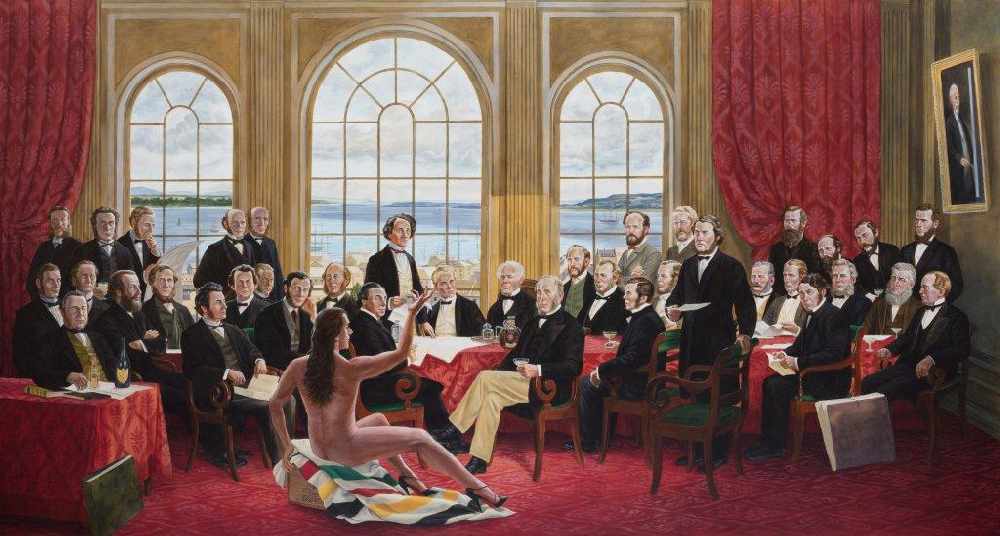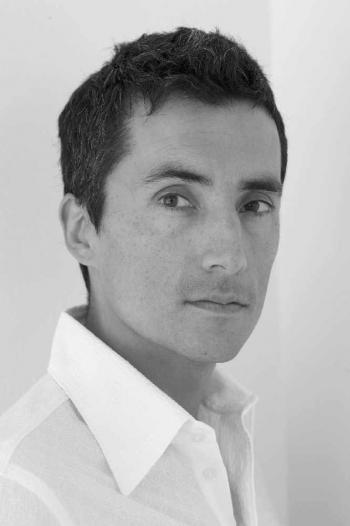Image Caption
By Barb Nahwegahbow
Windspeaker.com Contributor
The Daddies, by Cree artist Kent Monkman is part of the exhibition, Shame and Prejudice: A Story of Resilience, on view at the Art Museum at the University of Toronto until March 4.
If you haven’t seen it yet, best get a move on. Shame and Prejudice: A Story of Resilience, an exhibition that took Toronto art lovers by storm, is soon to close at the University of Toronto Art Museum March 4.
But good news for Calgary. The Glenbow Museum will host the exhibition in June.
“I never know how people are going to respond to the work when I make it,” said Cree artist Kent Monkman, “but this blew me away.” The size of the opening night crowd in Toronto was estimated at 1,000. Monkman’s biggest opening ever.
Overwhelming in its intensity, scope and size, Shame and Prejudice tells the history of Canada through Indigenous eyes, including a featured painting, The Scream, which deals with the violent removal of Indigenous children from their families by church and state.
The image speaks to a lot of people. “People whose families were touched by residential schools, people whose families were affected by the Sixties Scoop, or who themselves were affected by the Sixties Scoop.” A photo of the work went viral on Facebook when the exhibit opened.
“It’s an affirmation because the Truth and Reconciliation came out and we’ve seen the written evidence of it. But in art history, there is no image to authorize this event into the canon of our history and that was why I made it… There is a violence to it and I think it has really affected people.”
For Monkman, it was a difficult painting to do.
“When I thought about residential schools and the Sixties Scoop, for me the core of that was the removal of children and so I wanted to depict the action of children being removed from their parents. And anyone who has a child or has a relationship with children, it’s a horrific thing to comprehend having your child taken from you in a violent way. I think it has a universal appeal because any mother, regardless of your origin or ethnicity, would respond to that image. Not even just a mother; any human being with a heart.”
A member of Fisher River First Nation in Manitoba, Monkman grew up in Winnipeg. He gives special recognition to his great-grandmother who lived with them when he was growing up.
“She was my first audience and so endlessly patient and supportive of who I was,” he said. He credits his family and Saturday morning art classes at the Winnipeg Art Gallery for supporting and inspiring his creativity.
“I identified as an artist early on and I got quite good at it as a kid. The classes affirmed my own artistic identity and I point back to that as a moment that made me feel I belonged in an art gallery; a moment in time that really shaped me.”
Prejudice and Shame was almost three years in the making. One year was spent doing research, travelling across the country and delving into the collections of art galleries and museums. Monkman viewed not only the works on display, he said, but paintings, drawings and artifacts stored in vaults and dusty drawers.
Beaded moccasins worn by Chief Poundmaker, Saskatchewan Cree, are part of the exhibition, on loan from the Canadian Museum of History. Convicted of treason, Poundmaker was imprisoned in Stony Mountain Penitentiary. In the painting titled, The Subjugation of Truth, Poundmaker is wearing these moccasins along with leg irons as he sits with Chief Big Bear, also in leg irons. They are surrounded by all the colonial players as white hands hold out pens with which to sign the treaties also held by white hands.
“My mom is a little shocked,” Monkman said about his painting entitled “The Daddies”. He re-created the famous painting of the Fathers of Confederation, only with a strong Indigenous presence in the form of his alter ego, Miss Chief Eagle Testickle.
The lack of Indigenous people when their lands were being carved up by white European males to create the country of Canada had always bothered him. In his re-visioning of the original painting, Monkman inserted Miss Chief sitting naked on a Hudson’s Bay blanket, facing the daddies with her legs open.
He says his mom “wanted to put a loincloth and moccasins on me in that scene with the daddies,” said Monkman.
Shame and Prejudice: A Story of Resilience is about the survival of a people who have suffered starvation, the theft of their children, loss of land, spirituality, language and culture, disease, incarceration, dislocation and urban violence.
The exhibition is broken down into chapters dealing with different events relating to colonization.
“I didn’t want Canada in the title,” said Monkman, “because it’s a story that reaches across the border into the U.S. as well. A lot of similarities… what has happened to Indigenous people all over North America. It’s a story that should resonate all over Turtle Island.”
Monkman’s next project is not as heavy in tone as Shame and Prejudice, he said.
He’s taking on The Rendezvous; “international gatherings of Indigenous people, trappers, traders and mountain men, gatherings in the valleys beyond the Rockies in the early 19th century.
“I wanted to reflect on a time before the signing of the treaties where Indigenous people were on a more equal footing, still moving freely, not yet under government control.”
He describes the paintings as “exuberant and celebratory, a festive feeling to them.” That show will be in New York at the Gerald Peters Gallery March 1 – 25, and Peters Project in Sante Fe July 7 – September 2
For Shame and Prejudice, it will be on tour until 2020. Beyond the Glenbow Museum exhibition in Calgary, details on locations and dates can be found at: www/kentmonkman.com/events.

